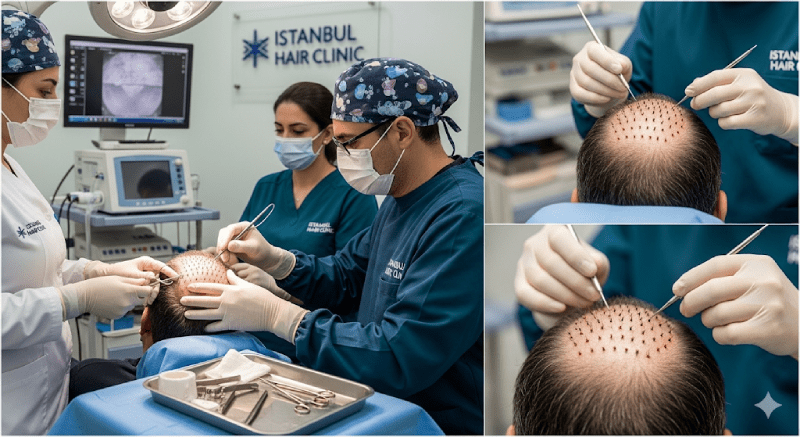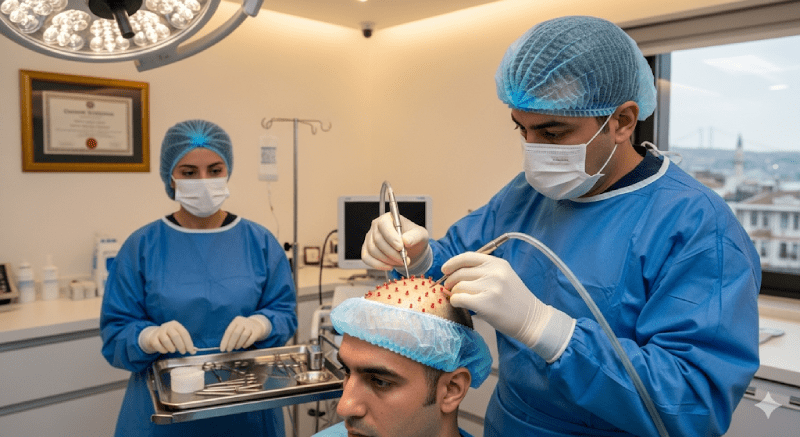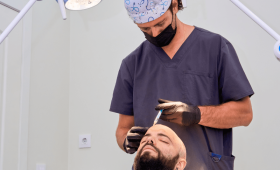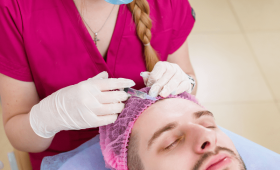What Is A Hair Transplant?
A hair transplant is a surgical procedure in which hair follicles are transferred from a donor area, where the person’s hair is genetically resistant to shedding, to bald or thinning areas. This procedure aims to increase hair density for individuals experiencing permanent hair loss and to achieve a fuller, natural-looking hairline. During the procedure, hair follicles are collected one by one and meticulously placed into the recipient areas. In this way, a natural and aesthetic result is obtained using the person’s own hair.
Who Is A Hair Transplant Suitable For?
A hair transplant is generally suitable for individuals over the age of 20 whose hair loss cycle has stabilized. One of the most important criteria is having a healthy donor area from which a sufficient number and quality of hair follicles can be harvested for the transplant.
Additionally, the person must be in good general health, with no chronic illnesses (such as uncontrolled diabetes or high blood pressure), to be suitable for the operation. A detailed examination by a specialist physician determines whether the person is a candidate for a hair transplant.
What Hair Transplant Methods Are Available?
The most common hair transplant methods used today include FUE (Follicular Unit Extraction) and DHI (Direct Hair Implantation). The FUE method is a technique where hair follicles are collected one by one with a special micromotor or manual punch, and then transplanted into pre-opened channels.
Sapphire FUE is a more precise variation of FUE where special sapphire-tipped blades are used instead of metal for the channel-opening phase. DHI, on the other hand, is a two-step procedure where hair follicles are transplanted directly after being collected with a special pen.
How Is The FUE Method Performed?
The FUE (Follicular Unit Extraction) method is one of the most fundamental steps of a hair transplant operation. In this method, the donor area is first numbed with local anesthesia, and hair follicles are collected one by one using a special micromotor or a manual punch. These collected follicular units are kept in a special solution to prevent damage. Then, small channels are opened in the bald area, considering the direction and angle of hair growth. Finally, the collected hair follicles are meticulously placed into these channels.
What Is The DHI Method And How Does It Differ From FUE?
The DHI (Direct Hair Implantation) method is a technique where the collection and transplantation of hair follicles are performed almost simultaneously. This method uses a special tool called a Choi implanter pen. The pen holds the hair follicle and performs both the channel opening and the transplantation in a single movement. This is the most significant difference from the FUE method. DHI causes less trauma to the transplant area, which is why it is preferred in cases where transplantation needs to be done among existing hairs.

Is A Hair Transplant A Painful Procedure?
Thanks to the local anesthesia administered beforehand, the pain level experienced by the patient during the hair transplant operation is minimized. There may be a slight stinging sensation when the anesthesia is injected, but this is a short-lived feeling. Once the anesthesia takes effect, no pain or discomfort is felt during the hair follicle extraction and transplantation phases. This ensures the patient has a comfortable experience throughout the operation.
How Long Does A Hair Transplant Operation Take?
The duration of a hair transplant operation varies depending on many factors. The most important factors are the number of grafts (hair follicles) to be transplanted and the hair transplant method used. Generally, procedures with a smaller number of grafts and simpler operations take less time, while high-number graft transplants, such as 4000-5000 grafts, can take between 6 to 8 hours or longer. The method used (FUE, DHI) also affects the operation time.
How Many Hair Follicles Are Transferred In A Hair Transplant?
The number of hair follicles to be transplanted in a hair transplant operation is determined individually for each patient, based on the degree of hair loss, the density of the donor area, and the quality of the existing hair follicles. In individuals with a sufficient donor area, a transplant of between 4000 to 5000 grafts can generally be performed, while this number can be around 1500-2000 grafts in cases of less severe hair loss. A detailed analysis by a specialist doctor is required before the operation to determine this number.
What Is The Donor Area?
The donor area is the region from which healthy and shedding-resistant hair follicles are collected for a hair transplant. This area does not experience hair loss because it is genetically insensitive to the dihydrotestosterone (DHT) hormone.
It is typically the back of the head, the area between the two ears. In cases where there is an insufficient number of hairs in the donor area, grafts can also be collected from other parts of the body, such as under the chin or from the chest hair. The follicles taken from this area retain their resistant properties in their new location.
When Do The Transplanted Hairs Start To Grow?
After a hair transplant operation, the growth process of the transplanted hairs consists of specific stages. First, a process called shock loss occurs within 2 to 4 weeks after the operation. This is normal. Starting from about the 3rd month, new hair follicles begin to grow, and a noticeable increase in density is observed in the 6th month. The most satisfactory and final result is generally achieved within 12 to 18 months. During this period, the hairs thicken and achieve a natural appearance.
What Side Effects Can Be Seen After A Hair Transplant?
After a hair transplant operation, some temporary side effects may be seen as a result of the body’s natural healing process. The most common are swelling and redness that can occur on the head and forehead, especially during the first few days after the operation. Additionally, a slight pain or ache may be felt, but this can be easily controlled with painkillers. As healing progresses, an itchy sensation may occur in the transplant and donor areas, which is a sign that new hairs are starting to grow.
Are The Results Of A Hair Transplant Permanent?
Yes, the results of a hair transplant are permanent. This is because the hair follicles used for the transplant are typically taken from the back of the head. The hair follicles in this area are genetically resistant to the dihydrotestosterone (DHT) hormone, which causes male-pattern hair loss. Therefore, they retain these properties in their new location and do not fall out over time. However, there is a possibility that the existing other hairs may continue to shed, so the transplanted hairs are permanent.
When Can I Wash My Hair After The Procedure?
The first wash after a hair transplant operation is a critical step for the healthy settlement of the hair follicles and the success of the operation. It is generally performed on the third day after the operation with a special shampoo and lotion recommended by the clinic. This wash is carried out by a specialized nurse using gentle movements. After the first wash, the patient can continue to wash their hair themselves, following the instructions given by the clinic.
What Is The Ideal Age Range For A Hair Transplant?
The ideal age range for a hair transplant is generally when the hair loss process has stopped or slowed down. This period occurs in most individuals between the ages of 25 and 40. In hair transplants performed at an early age, a new operation may be needed in the future as the shedding process may continue. Therefore, a hair transplant is not recommended before the hair loss has stabilized to ensure the operation yields more permanent results and does not create future aesthetic problems.
Is A Hair Transplant Suitable For Everyone?
Although a hair transplant is a common operation, it is not suitable for everyone. Before the operation, the patient’s general health status should be evaluated in detail. The operation may carry a risk for individuals with chronic illnesses such as uncontrolled diabetes, high blood pressure, or heart conditions. Additionally, the basic condition for a hair transplant is to have a donor area with a sufficient number of healthy hair follicles for transplantation. People with an insufficient donor area may not be suitable candidates for a hair transplant.
Who Should Perform A Hair Transplant Operation?
Since a hair transplant is a surgical procedure, it must be performed by a team led by an experienced aesthetic surgeon or dermatologist who specializes in this field. Operations performed by inexperienced hands can carry health risks and may not yield the desired natural and aesthetic results. In a quality clinic, the entire process before and after the operation is monitored by a specialist doctor, and patient safety is kept at the highest level.
When Do The Transplanted Hairs Look Natural?
The process of transplanted hair gaining a natural appearance is a process that requires patience. Within the first few months, the hairs adapt to their new location and begin to grow. Around the 6th month, most of the hairs have grown and become more prominent, and at this point, the appearance starts to look more natural. By the end of one year, the transplanted hairs have fully thickened, their roots have strengthened, and they have gained a natural and full appearance in harmony with the surrounding existing hairs.

What Should I Pay Attention To After A Hair Transplant?
The first few weeks after a hair transplant operation are crucial for the healthy progression of the healing process. During this period, smoking and alcohol consumption should be strictly avoided, as these substances can negatively affect blood circulation and slow down healing. Additionally, one should stay away from strenuous sports and direct exposure to sunlight. It is also important to avoid head bumps, pay attention to sleep position, and regularly use the medications prescribed by the clinic.
What Is Shock Loss After A Hair Transplant?
Shock loss is a natural process where a large portion of the transplanted hairs falls out approximately 2 to 4 weeks after the hair transplant operation. This condition is caused by the stress experienced by the hair follicles during the operation. The hairs that fall out are just the strands, not the roots. The roots remain under the skin. This shedding makes way for new and stronger hair to grow. This process is completely normal and does not mean the operation has failed.
How Does The Process Work For International Patients For A Hair Transplant?
For patients coming from abroad, hair transplant clinics usually offer a comprehensive package service. These packages typically include transfer services from the airport to the hotel and clinic, accommodation for a specified period, and all necessary examinations and care before and after the operation.
In this way, patients do not have to deal with logistical details such as accommodation and transportation in addition to the operation. These packages ensure that patients can go through the process in a more comfortable and organized manner.
Can Women Get A Hair Transplant?
Yes, women can also get a hair transplant. However, since hair loss in women is often in the form of diffuse thinning, it is more difficult to identify a suitable candidate for a hair transplant. The operation is generally more suitable for women who have male-pattern hair loss or localized hair loss, such as a receding hairline. Women who have a sufficient and healthy donor area, meaning hair follicles that are resistant to shedding, can be considered for the operation.
What Determines Hair Transplant Prices?
Hair transplant prices vary depending on many factors rather than a single standard price. The most important factors affecting pricing are the number of hair follicles (grafts) to be transplanted, the transplant method used (FUE, DHI, Sapphire FUE, etc.), and the location of the clinic. Additionally, the experience of the team performing the operation and the additional services provided by the clinic (e.g., accommodation, transfers, post-operative care kits) also play a role in pricing.
Is It Possible To Transplant Hair From The Beard Or Body?
Yes, it is possible to transplant hair from the beard or body hair, and this method is usually preferred in situations where the donor area on the back of the head is insufficient. Beard hairs are the closest in thickness and structure to scalp hairs, which is why they are frequently preferred. Chest or back hairs can also be used, but the hair structure is different from scalp hair and therefore the results may not look as natural.
What Are The Special Tools Used In Hair Transplantation?
The special tools used in modern hair transplant operations are of great importance for the success of the procedure and patient comfort. Micromotors allow for the fast and safe collection of hair follicles from the donor area. Sapphire-tipped blades are used during the channel-opening phase in the recipient area to create smoother and more precise incisions. Choi implanter pens, on the other hand, allow for both the channel opening and the transplantation of hair follicles to be done in a single motion.
When Is The Bandage Removed After A Hair Transplant?
Immediately after the hair transplant operation, a light bandage is applied to the donor area to support the healing process and stop any potential bleeding. This bandage is usually carefully removed by specialists during the first check-up on the day after the operation. This allows the operation area to be exposed to the air and speeds up healing. The recipient area is usually left uncovered.
What Is The Success Rate Of A Hair Transplant?
The success rate of a hair transplant operation depends on multiple factors. When performed by an experienced and specialized team and with a suitable candidate for the transplant, the success rate can be over 95%. Success is measured not only by the survival of the transplanted follicles but also by the natural appearance of the hairline and the overall aesthetic results obtained after the operation. Therefore, choosing the right clinic and specialist directly affects the success of the operation.
Can A Hair Transplant Be Done On Thinning Hair Areas?
Yes, a hair transplant operation can be applied not only to completely bald areas but also to thicken thinning hair areas. This procedure is done by carefully transplanting new hair follicles between the existing hairs. In this way, the overall hair density is increased, and a fuller appearance is achieved. This offers an effective solution for hair thinning problems, which are common in women, and is performed without damaging the existing hair.
Is Swelling Normal After A Hair Transplant?
Right after the hair transplant operation, it is completely normal for slight swelling to occur on the forehead and around the eyes due to the fluid injection into the scalp and the trauma from the operation itself. This condition usually becomes noticeable within 2-3 days after the operation and goes away on its own within a week. To reduce swelling, patients are advised to keep their heads elevated and use the medications recommended by the doctor.
Why Does Itching Occur After A Hair Transplant?
The itching felt after a hair transplant is a natural sign that the operation area is entering the healing process. This itching occurs during the settlement of the new hair follicles and the healing of nerve endings in the operation area. It is very important to absolutely avoid scratching during this period, as scratching can damage the transplanted follicles and increase the risk of infection. Lotions recommended by clinics can be used to relieve the itching.
Can I Get A Second Hair Transplant Operation?
Yes, if hair loss continues after the first operation or if you want to achieve more density, it is possible to have a second hair transplant operation. However, the basic condition for this operation is that there must be a sufficient amount of healthy hair follicles in your donor area. It is generally advised to wait at least 1 year after the first operation before having a second one, so that the results of the first operation can be fully seen and the donor area can heal completely.

How Long Does It Take For The Transplanted Hair To Return To Its Natural Color?
After a hair transplant operation, it takes some time for the transplanted hair follicles to fully regain their natural color and texture. When they first grow, the new hair strands may be thinner and lighter in color. However, as the follicles settle into their new place and blood circulation returns to normal, the hair begins to thicken and take on the natural color and texture from the person’s genetic makeup. This process varies from person to person but is generally completed within a few months.
Does The Season Matter For A Hair Transplant?
Thanks to technological advancements, a hair transplant operation can be safely performed in any season of the year. The season does not have a direct impact on the success of the operation. However, individuals having the operation in the summer months should take extra care to protect themselves from direct sunlight and excessive sweating after the operation. For this reason, winter and spring months might be more comfortable for those who want to have a more relaxed healing process.
Can I Dye My Hair After A Hair Transplant?
After a hair transplant operation, a certain period must be waited before hair dyeing. The chemical substances in hair dye can damage the sensitive hair follicles in the transplant area and negatively affect the healing process. Therefore, it is generally recommended to avoid hair dyeing or chemical treatments for the first 6 months after the operation to allow the transplanted hair and scalp to heal completely. After 6 months, dyeing can be done with a doctor’s approval.
Will The Transplanted Hair Be Like My Other Hair?
Yes, since the hair follicles used in a hair transplant are the person’s own hair, they retain their genetic characteristics in their new location. This means that the growth rate, thickness, and texture of the transplanted hair will be the same as the hair from the donor area. Therefore, the transplanted hair will grow naturally, can be cut, and can be styled. This is one of the biggest advantages of a hair transplant and ensures a natural result.
Does A Hair Transplant Leave A Scar?
With modern hair transplant methods such as FUE and DHI, there is no visible scarring. These methods involve creating very small, millimeter-sized holes in the areas where hair follicles are collected and transplanted. These holes close almost completely during the healing process and are very difficult to notice. Much more aesthetic results are obtained compared to older methods, and a scar-free appearance is provided.
What Is The Difference Between A Hair Transplant And A Hair Prosthesis?
Hair transplant and hair prosthesis are fundamentally two different solutions. A hair transplant is a permanent surgical procedure that uses a person’s own hair follicles. As a result of this procedure, one has live hairs that grow and do not fall out. A hair prosthesis, on the other hand, is a non-surgical method; it is a piece made of natural or synthetic hair that is applied to the bald area. While a hair prosthesis requires continuous maintenance and renewal, a hair transplant offers a permanent solution.
Can I Use Gel Or Hairspray On My Hair After A Hair Transplant?
After a hair transplant operation, it is recommended to stay away from products containing chemicals for the first few months for the health of the transplant area and the survival of the follicles. Cosmetic products such as gel, hairspray, and foam can irritate the sensitive scalp due to the chemicals they contain and can negatively affect the healing process. Therefore, during the post-operative period, only special care products like the shampoo and lotions recommended by your doctor should be used.
When Can I Wear A Hat After A Hair Transplant?
It is recommended not to wear a hat for the first 10 days after a hair transplant operation to allow the operation area to breathe and to prevent the transplanted hair follicles from shifting. During this period, it is especially important to avoid tight and constricting hats. After the 10th day, if you need to go outside, you can wear a wide-brimmed hat or beanie that is not too tight and allows air circulation.
How Should I Choose Between FUE And DHI For A Hair Transplant?
The decision to choose between the FUE and DHI methods for a hair transplant operation should be made based on the patient’s individual needs and the doctor’s expertise. FUE is generally preferred for cases where larger areas need to be transplanted, while DHI can be advantageous for smaller areas and for thickening hair among existing hairs. When making this decision, factors such as the condition of your donor area, the type of your hair loss, and your desired results should be considered.
Can I Exercise After A Hair Transplant?
After a hair transplant operation, it is necessary to avoid sports and strenuous exercise for a while. Especially for the first 10 days after the operation, intense exercises that can cause sweating and pressure on the scalp should be avoided. Excessive sweating can increase the risk of infection, and an increase in blood pressure can damage the transplanted follicles. After this period, you can start with exercises like light-paced walking with your doctor’s approval.



